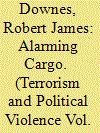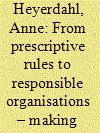| Srl | Item |
| 1 |
ID:
178933


|
|
|
|
|
| Summary/Abstract |
Programme CYCLAMEN was initiated to manage the risk of non-conventional terrorism in the United Kingdom following Al-Qaeda’s attacks against the United States in 2001. Under Programme CYCLAMEN, the UK developed a border monitoring capability to detect and deter the illicit cross-border movement of radiological and nuclear materials by malicious non-state actors. This paper examines the development of border monitoring technologies before and after 9/11 with a focus on Programme CYCLAMEN using two models of state response to terrorism. Under the Control Model, state agencies seek to manage the risk associated with terrorism through disruption of terrorist activities. Under the Regulatory Model, actions are conceptualised as safeguarding public health and safety from various sources of risk including terrorism. The Regulatory Model is found to be dominant before 9/11 but the Control Model dominated thereafter and Programme CYCLAMEN is best understood as emanating from the Control Model. However, earlier action under the Regulatory Model shaped later consideration of this particular border-based protective security measure. This paper explores this shaping process and concludes that the Regulatory Model is under-considered as a model of state response to terrorism.
|
|
|
|
|
|
|
|
|
|
|
|
|
|
|
|
| 2 |
ID:
190063


|
|
|
|
|
| Summary/Abstract |
Protective security management aims at protecting against malicious acts. It has, in a relatively short period, undergone substantial changes. One such change is the introduction of risk management. This article investigates a debate about a standard for security risk assessment (SRA) in Norway. It focuses on sense-making by security professionals, drawing on a unique interview material. The analysis utilises Michael Power’s theory on risk governance, as well as insights from security studies. A central finding is that the SRA approach was introduced to create more analytical security management. The importance of analysing one’s values (assets) makes it key to scrutinise the organisation’s characteristics, goals and vulnerabilities, regarded as moving security management in the direction of corporate governance. The article investigates how understanding of risk assessment and security interplay, and identifies a tension between risk (assessment) and the goal of protection, which makes security management risk averse. A requirement of creating sound security is viewed as a potential for burdensome organisational responsibility and blame. The analysis identifies elements of what is often described as resilience (attention towards vulnerabilities), but without the political reading (neo-liberal abdication of the state), thus contributing to the literature on resilience.
|
|
|
|
|
|
|
|
|
|
|
|
|
|
|
|